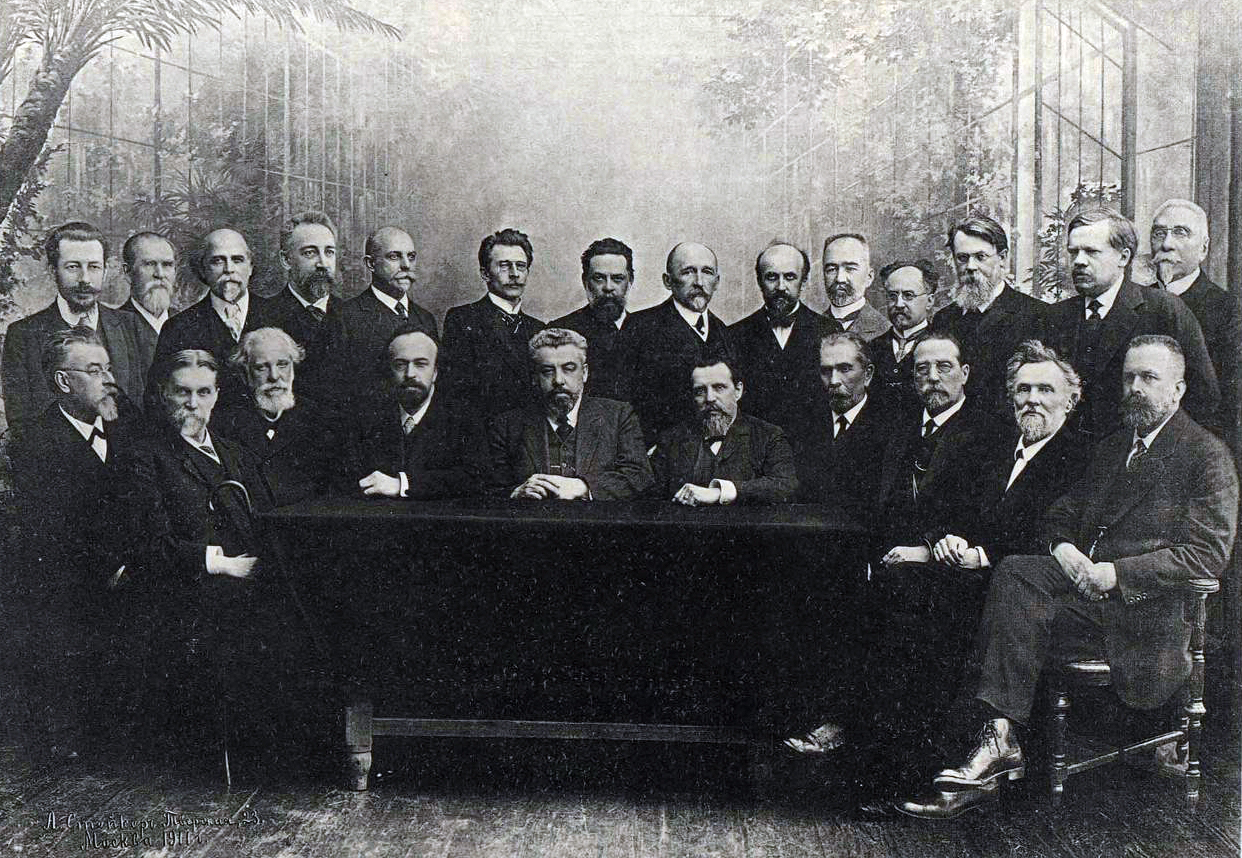|
Isaac Mustafin
Isaac Mustafin (russian: Исаак Савельевич Мустафин) (1908–1968) was a Soviet chemist and a doctor of chemical sciences. Dr. Mustafin headed the faculty of analytical chemistry at Saratov State University from 1955. All his life was connected to the Saratov State University: his only lengthy absence from his work place took place from June 23, 1941 to August 15, 1945, when he served in the army. The life and activity of Professor Mustafin were reflected in a number of papers –7and even monographs –9 including that in the series of scientific biographic literature of the Nauka publishing house (See also 0. The unusual biography and diversified interests of the scientist have attracted the attention of chemists, historians, philosophers, and writers. In fact, a characteristic feature of I.S. Mustafin was the broad spectrum of his scientific interests: he successfully worked in analytical, organic, physical, and inorganic chemistry; bio- and geochem ... [...More Info...] [...Related Items...] OR: [Wikipedia] [Google] [Baidu] |
Analytical Chemistry
Analytical chemistry studies and uses instruments and methods to separate, identify, and quantify matter. In practice, separation, identification or quantification may constitute the entire analysis or be combined with another method. Separation isolates analytes. Qualitative analysis identifies analytes, while quantitative analysis determines the numerical amount or concentration. Analytical chemistry consists of classical, wet chemical methods and modern, instrumental methods. Classical qualitative methods use separations such as precipitation, extraction, and distillation. Identification may be based on differences in color, odor, melting point, boiling point, solubility, radioactivity or reactivity. Classical quantitative analysis uses mass or volume changes to quantify amount. Instrumental methods may be used to separate samples using chromatography, electrophoresis or field flow fractionation. Then qualitative and quantitative analysis can be performed, often with t ... [...More Info...] [...Related Items...] OR: [Wikipedia] [Google] [Baidu] |
Saratov State University
Saratov Chernyshevsky State University (russian: Саратовский государственный университет имени Н. Г. Чернышевского, СГУ, transcribed as SGU) is a major higher education and research institution in Russia. Named for Nikolay Chernyshevsky, the university was founded in 1909 under the name Imperial Saratov University by the Decree of Emperor Nicholas II. On June 10, 1909, the Emperor signed the "Decree on the foundation of the university in Saratov", which became the tenth University in Russia and consisted of the Medical Faculty only. Professor Vasili Razumovsky, V.I. Razumovsky became the first university rector. He was a public figure, surgeon, and scientist who is considered to be the founder of a neurosurgery school in Russia. Construction of major university buildings as well as the university clinic named after S.R. Mirotvortsev was carried out under the supervision of the talented Russian architect Karl Hermann Ludwig ... [...More Info...] [...Related Items...] OR: [Wikipedia] [Google] [Baidu] |
Mellitic Acid
Mellitic acid, also called graphitic acid or benzenehexacarboxylic acid, is an acid first discovered in 1799 by Martin Heinrich Klaproth in the mineral mellite (honeystone), which is the aluminium salt of the acid. It crystallizes in fine silky needles and is soluble in water and alcohol. Preparation Mellitic acid may be prepared by warming mellite with ammonium carbonate, boiling off the excess of the ammonium salt, and adding ammonia to the solution. The precipitated alumina is filtered off, the filtrate evaporated, and the ammonium salt of the acid purified by recrystallization. The ammonium salt is then converted into the lead salt by precipitation with lead acetate, and the lead salt is then decomposed by hydrogen sulfide. The acid may also be prepared by the oxidation of pure carbon, graphite or hexamethylbenzene, by alkaline potassium permanganate in the cold, or by hot concentrated nitric acid. Reactions It is a very stable compound; chlorine, concentrated nitric aci ... [...More Info...] [...Related Items...] OR: [Wikipedia] [Google] [Baidu] |
Nikolay Zelinsky
Nikolay Dmitriyevich Zelinsky (; 6 February 1861 – 31 July 1953) was a Russian Empire, Russian and USSR, Soviet chemist. Academician of the Academy of Sciences of the Soviet Union (1929). Zelinsky studied at the University of Odessa and at the universities of Leipzig and Göttingen in Germany. Zelinsky was one of the founders of theory on Organic chemistry, organic catalysis. He was the inventor of the first effective filtering activated charcoal gas mask in the world (1915). Life Nikolai Zelinsky was born on 25 January (February 6, 6 February) 1861 in Tiraspol in a noble family. His father Dmitry Osipovich Zelinsky who came from hereditary Volyn nobles, died of rapidly developing consumption in 1863; two years later his mother died of the same disease. The orphaned boy was left in the care of his grandmother M.P. Vasilyeva and he spent his childhood in her village. At the age of ten, Nikolai Zelinsky entered the Tiraspol district school for two-year courses to prepare for ent ... [...More Info...] [...Related Items...] OR: [Wikipedia] [Google] [Baidu] |
Doklady Akademii Nauk
The ''Proceedings of the USSR Academy of Sciences'' (russian: Доклады Академии Наук СССР, ''Doklady Akademii Nauk SSSR'' (''DAN SSSR''), french: Comptes Rendus de l'Académie des Sciences de l'URSS) was a Soviet journal that was dedicated to publishing original, academic research papers in physics, mathematics, chemistry, geology, and biology. It was first published in 1933 and ended in 1992 with volume 322, issue 3. Today, it is continued by ''Doklady Akademii Nauk'' (russian: Доклады Академии Наук), which began publication in 1992. The journal is also known as the ''Proceedings of the Russian Academy of Sciences (RAS)''. ''Doklady'' has had a complicated publication and translation history. A number of translation journals exist which publish selected articles from the original by subject section; these are listed below. History The Russian Academy of Sciences dates from 1724, with a continuous series of variously named publications dat ... [...More Info...] [...Related Items...] OR: [Wikipedia] [Google] [Baidu] |
Titration
Titration (also known as titrimetry and volumetric analysis) is a common laboratory method of quantitative chemical analysis to determine the concentration of an identified analyte (a substance to be analyzed). A reagent, termed the ''titrant'' or ''titrator'', is prepared as a standard solution of known concentration and volume. The titrant reacts with a solution of ''analyte'' (which may also be termed the ''titrand'') to determine the analyte's concentration. The volume of titrant that reacted with the analyte is termed the ''titration volume''. History and etymology The word "titration" descends from the French word ''titrer'' (1543), meaning the proportion of gold or silver in coins or in works of gold or silver; i.e., a measure of fineness or purity. ''Tiltre'' became ''titre'', which thus came to mean the "fineness of alloyed gold", and then the "concentration of a substance in a given sample". In 1828, the French chemist Joseph Louis Gay-Lussac first used ''titre'' as ... [...More Info...] [...Related Items...] OR: [Wikipedia] [Google] [Baidu] |
Lev Chugaev
Lev Aleksandrovich Chugaev (16 October 1873 – 26 September 1922) was a Russian chemist. At the height of his career, he was professor of chemistry at the University of Petersburg, being the successor to Dmitri Mendeleev. He was active in the fields of inorganic chemistry, especially platinum group Complex (chemistry), complexes, as well as organic chemistry. He is also known as Leo Aleksandrovich Tschugaeff or Tschugaev. Contributions to coordination chemistry Chugaev discovered that dimethylglyoxime forms a scarlet solid upon reaction with nickel(II) ions. This reaction was one of the first "spot tests" for a metal ion. An adherent to the theories of Alfred Werner, Chugaev made several contributions to the chemistry of platinum. The salt [Pt(NH3)5Cl]Cl3 containing the chloropentammineplatinum(IV) ion, is called "Chugaev's salt". Other complexes prepared in his laboratory include [Pt(Diethyl sulfide, SEt2)4][PtCl4], [Pt(NH3)5OH]Cl3, [Os(thiourea, SC(NH2)2)6]Cl3.H2O. Chugae ... [...More Info...] [...Related Items...] OR: [Wikipedia] [Google] [Baidu] |
Soviet Chemists
This list of Russian chemists includes the famous chemists and material scientists of the Russian Federation, the Soviet Union, the Russian Empire and other predecessor states of Russia. Alphabetical list __NOTOC__ A *Aleksandr Arbuzov, discovered Arbuzov reaction. B * Alexander Baykov, an academician of the Russian Academy of Sciences, USSR Academy of Sciences. *Ernest Beaux, inventor of Chanel No. 5, ''"the world's most legendary fragrance"'' *Nikolay Beketov, inventor of aluminothermy, a founder of physical chemistry *Friedrich Konrad Beilstein, proposed the Beilstein test for the detection of halogens, author of the Beilstein database in organic chemistry *Boris Pavlovich Belousov, Boris Belousov, chemist and biophysicist, discoverer of Belousov–Zhabotinsky reaction, a classical example of non-equilibrium thermodynamics *Alexander Borodin, chemist and composer, the author of the famous opera ''Prince Igor'', discovered Borodin reaction, co-discovered Aldol reaction *Al ... [...More Info...] [...Related Items...] OR: [Wikipedia] [Google] [Baidu] |
1908 Births
Nineteen or 19 may refer to: * 19 (number), the natural number following 18 and preceding 20 * one of the years 19 BC, AD 19, 1919, 2019 Films * ''19'' (film), a 2001 Japanese film * ''Nineteen'' (film), a 1987 science fiction film Music * 19 (band), a Japanese pop music duo Albums * ''19'' (Adele album), 2008 * ''19'', a 2003 album by Alsou * ''19'', a 2006 album by Evan Yo * ''19'', a 2018 album by MHD * ''19'', one half of the double album ''63/19'' by Kool A.D. * ''Number Nineteen'', a 1971 album by American jazz pianist Mal Waldron * ''XIX'' (EP), a 2019 EP by 1the9 Songs * "19" (song), a 1985 song by British musician Paul Hardcastle. * "Nineteen", a song by Bad4Good from the 1992 album '' Refugee'' * "Nineteen", a song by Karma to Burn from the 2001 album ''Almost Heathen''. * "Nineteen" (song), a 2007 song by American singer Billy Ray Cyrus. * "Nineteen", a song by Tegan and Sara from the 2007 album '' The Con''. * "XIX" (song), a 2014 song by Slipkn ... [...More Info...] [...Related Items...] OR: [Wikipedia] [Google] [Baidu] |



